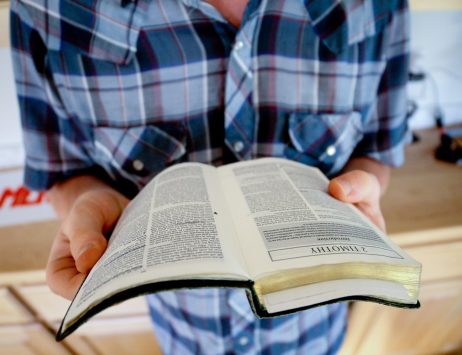The week before I entered the Catholic Church, a friend took me to a Benedictine monastery. We arrived well after the monastic community had retired for the evening, but a monk in a black habit greeted us and showed us to our rooms. This was my first experience with the famed Benedictine hospitality. “All guests who present themselves are to be welcomed as Christ, for he himself will say: I was a stranger and you welcomed me,” as the Rule of Saint Benedict directs.
That weekend introduced me to a way of life that continuously informs my idea of what it means to be Catholic. I am a happily married man with four amazing children, and somehow a rule created initially for celibate men living in community is my most important resource for being faithful to my commitments as a Christian, as a citizen in the world, as a husband, and as a father. From the beauty of the chanted psalms to the seamless rhythm of work and prayer, monks’ dedication to their vows of obedience, stability, and conversion of life has taught me much about what it means to be a human striving after God.
What is the Benedictine Way?
Benedict was born around 480 AD in central Italy to an elite Roman family. We don’t know what made him dissatisfied with his life of privilege and influence, but as a young man Benedict fled his studies in Rome and spent several years living by himself in the mountains, seeking God in solitude and prayer. Monasteries at that time were relatively new experiments in Christian communal living, and as word got around about the strange hermit living in the mountains, aspiring monks sought Benedict’s leadership. After a failed start or two, Benedict succeeded in founding around a dozen monasteries, some of which are still thriving communities today. And he wrote his famous Rule, a synthesis of earlier monastic guidelines that is noteworthy for its clear understanding of human nature. Benedict’s Rule strikes a careful balance between an intense desire to imitate Christ and the realistic demands of sustainable community.
How do you create a healthy, long-lasting community of very different personalities who are nevertheless all seeking God? The Rule of Saint Benedict offers one of the most longstanding and successful answers to this question. Each of the three vows that monks take upon joining the community has had something important to say to ordinary Catholics like me.
The Three Benedictine Vows
Obedience, in the Benedictine context, is not blind submission to authority but a willingness to listen and follow wise counsel. For lay people, this vow can be understood as a commitment to being open to guidance from spiritual mentors, the teachings of the Church, and the promptings of conscience. The vow of obedience says: “Listen!”
The vow of stability is fundamentally about the gift of human limitation. For monks, stability means that they belong to a particular community and will live out the rest of their lives as monks of that place. For me, the value of stability is a call to rootedness in my faith, in my family, and in my parish. God is present here and now, in the life I am actually living, and in the relationships that I actually have, not in some imaginary version of my life. The vow of stability says, “Be here now!”
Finally, the vow of conversion, or continuous striving after Christ, challenges us to see our lives as a work in progress. This vow helps me to see all my goals and aspirations within the bigger context of God’s own plan for my life, and it helps me to let go of what I can’t control. The vow of conversion says, “Trust!”
Learning from the Benedictine Way
There are many other treasures in the Rule of Saint Benedict, including the rhythm of work and prayer, the value of hospitality, and the importance of reading the Bible, to name just a few. All of them show how Benedictine spirituality is a flexible and powerful set of tools for seeking Christ during normal life.
I spent a lot of time at that Benedictine monastery over the years. For a minute I considered becoming a monk, but marriage turned out to be my path to happiness and wholeness. Still, the monastic community presents me with the best image of what the church can be: an eclectic, even quirky group of individuals whose commitment to Christ and to their common life is placed before all other considerations, all under the flexible leadership of one of their peers chosen for his ability to serve the community. With a little imagination, we can listen to what Saint Benedict might say about Christian family life, or the Catholic parish, or even the workplace. As we journey through life, may we heed the wisdom of Saint Benedict and strive for obedience, stability, and conversion in our own lives, finding in his Rule a timeless guide for pursuing Christ amid our ordinary days.




